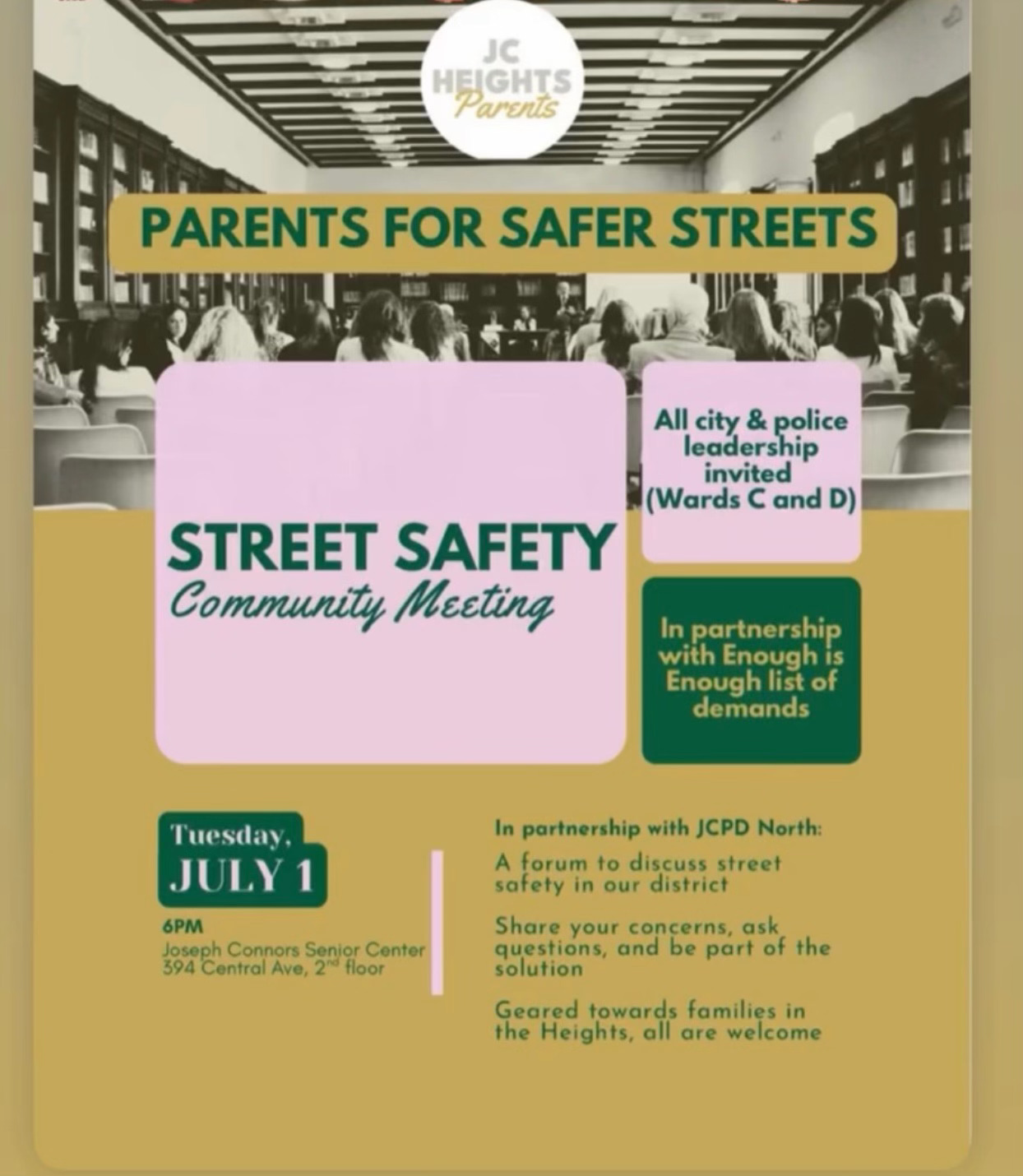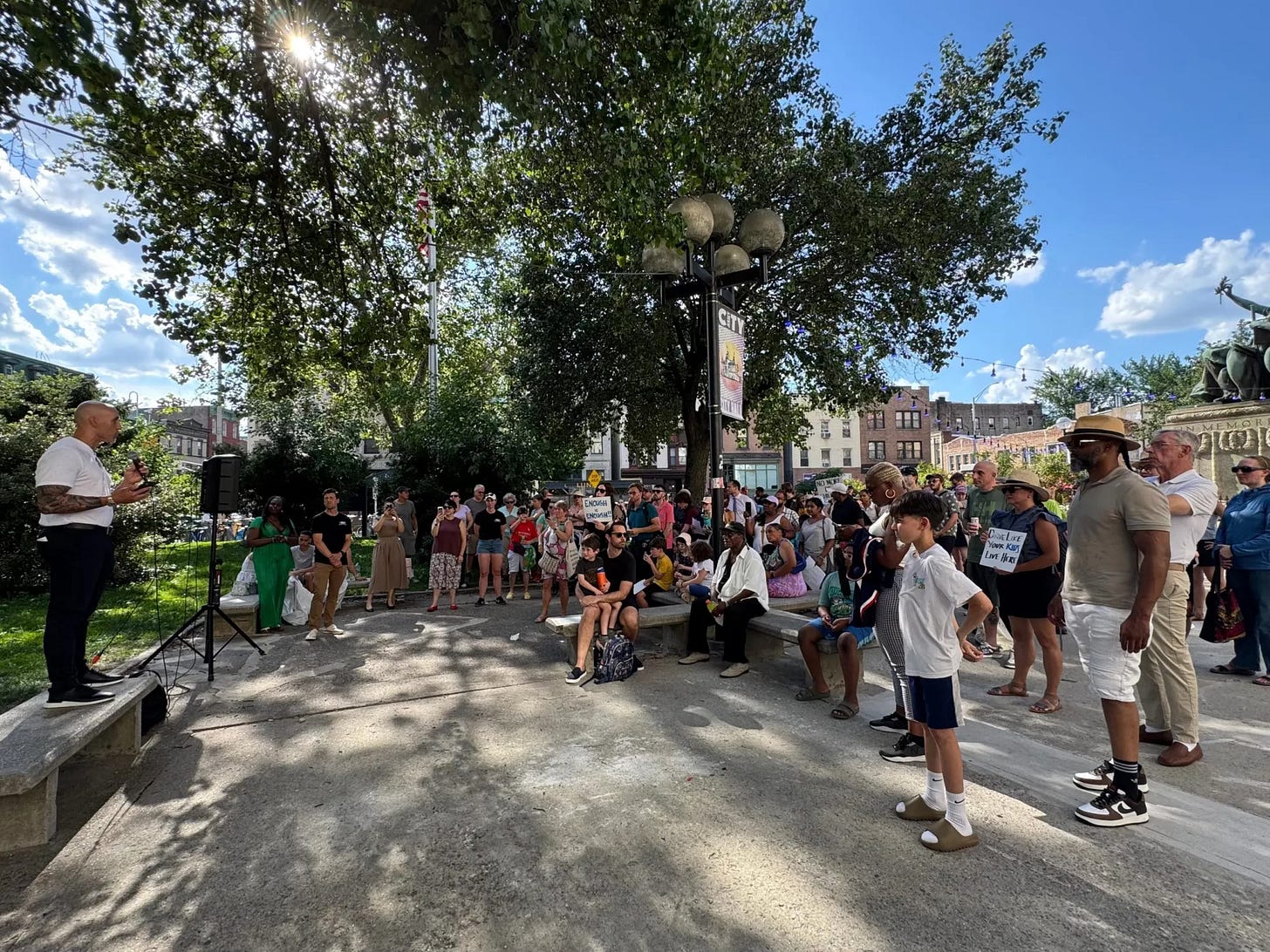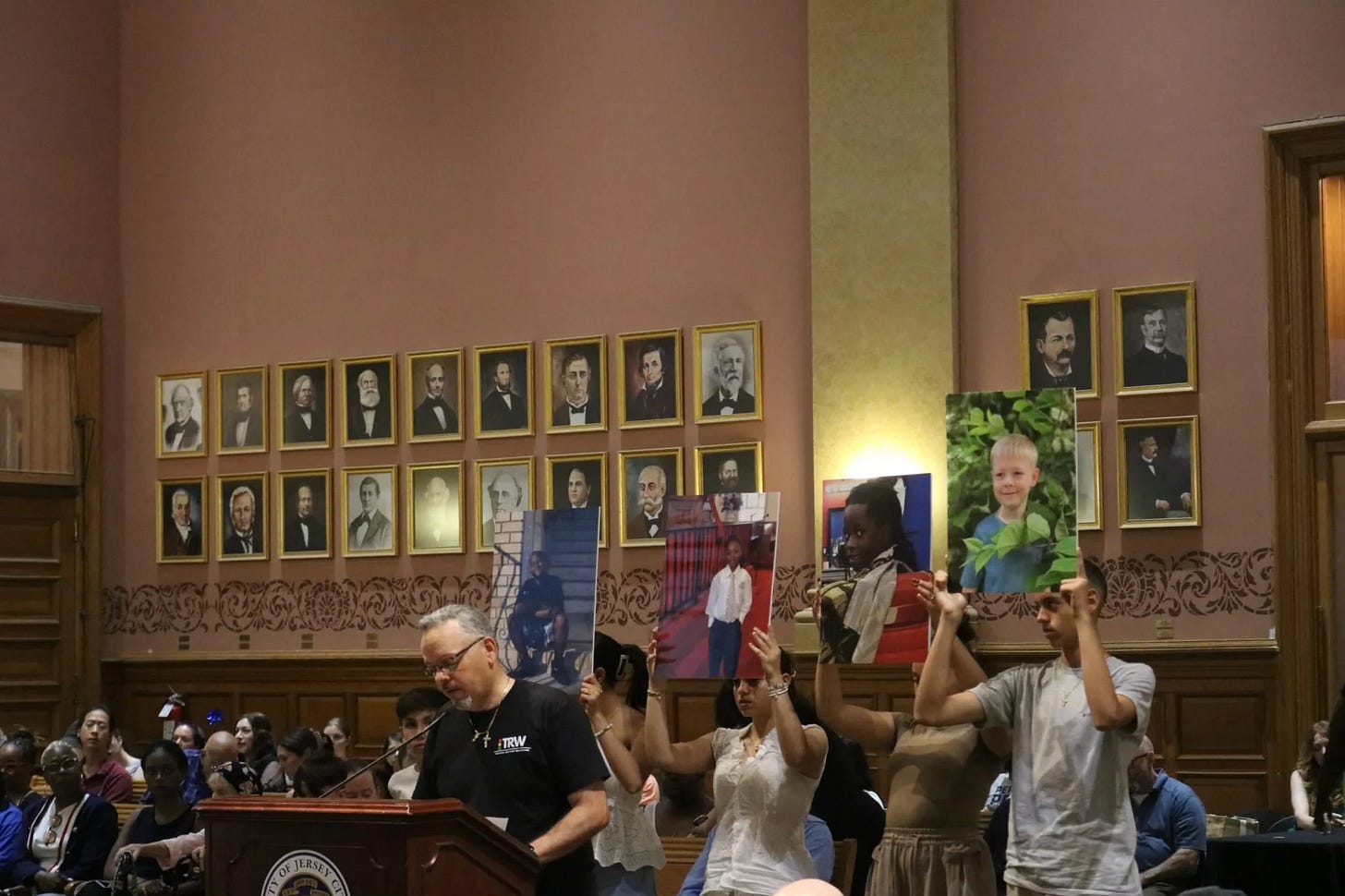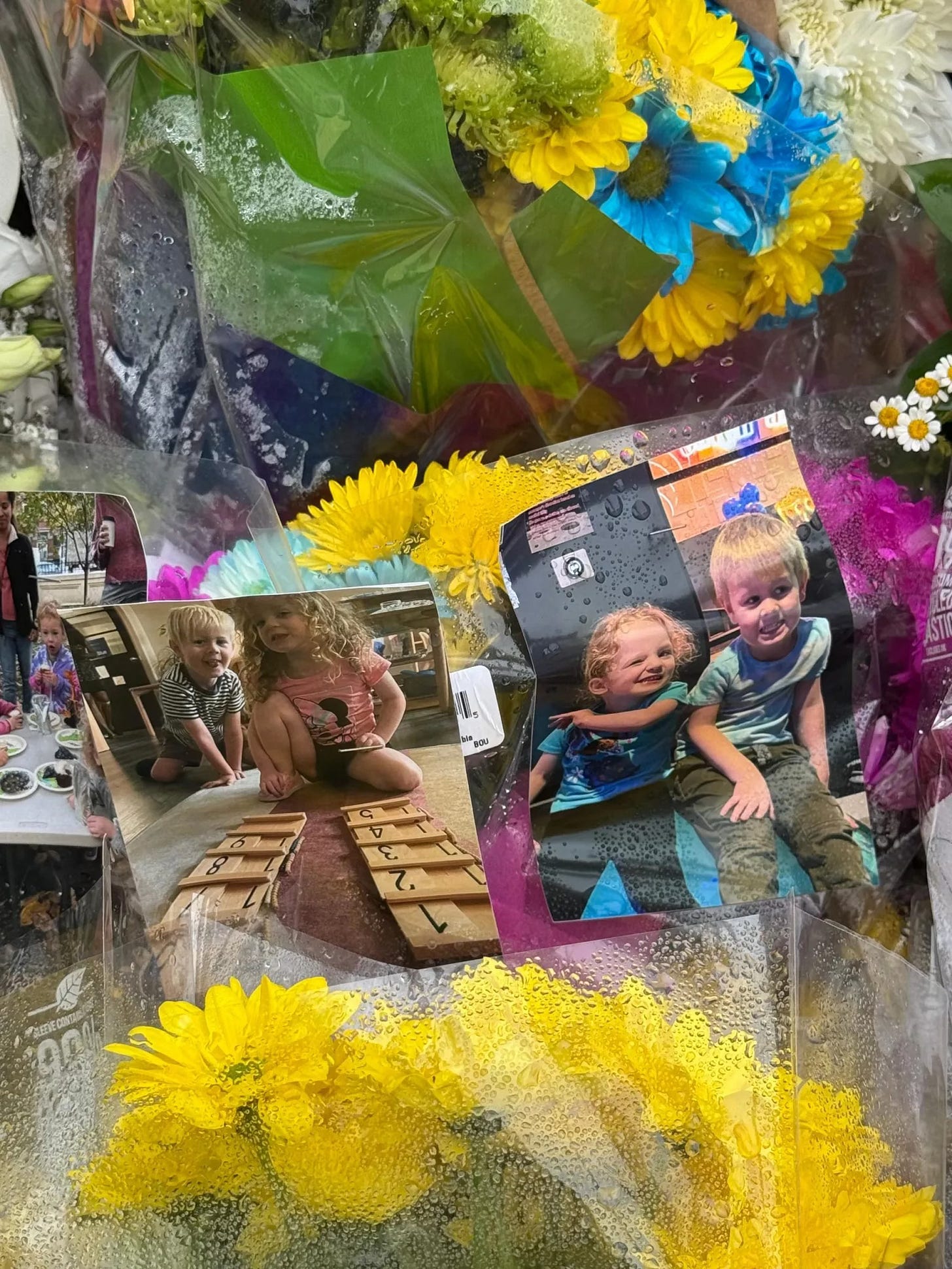A Community Meeting Held In The Wake of a Recent Loss of Life. What Will Reform Look like in the Streets of JC?
The following piece was originally published on NJ Urban News.

Parents, community activists, and residents were at the drawing board on Tuesday night, to discuss public safety efforts in the streets of Jersey City, this comes at the helm of the death of Eli Bender, a six-year-old who was struck by a UPS driver at the corner of Jersey Avenue and Sixth Street.
Those in attendance at the “Street Safety Community Meeting” brought several discussions of addressing street and pedestrian safety, chief among them, were talks as to the city’s rationale behind the lack of traffic enforcement officers and traffic safety.
The meeting was held at the Joseph Connors Senior Center at 394 Central Ave. Public Safety Director James Shea, emphasized that Eli Bender’s fatal death was a tragic accident, after reviewing several sets of footage reviewed by officials—both stemming from the Hudson County Prosecutor’s Office Regional Collision Investigation Unit and Jersey City Police Department.
He made known to the public, the challenges faced by the city in hiring a new set of police officers who’d focus on traffic safety and instead emphasized the need to raise wages for JCPD officers to keep them in Jersey City, rather than leave to other cities.
The meeting was an open invite for, “All city and police leadership,” within Wards C and D and to the public. The meeting was hosted by JC Heights Parents.
“The meeting was critical in terms of getting all the appropriate stakeholders and community in the room so we can address the tragic death that just occurred, address any concerns, and find a path forward for better street safety and more enforcement,” said Jersey City Councilman Ward D Yousef Saleh to JC IN THE NEWS, who was in attendance at the meeting, hearing out the concerns brought by the public on the matter.
Article at New Jersey Urban News begins here:
Jersey City’s Long-Term Plan In Pedestrian Safety, The Cost Of One Six-Year-Old Life

“Enough is enough,” echoed protestors in front of the steps of City Hall as residents, families, and members of the community convened Wednesday to honor the name of Eli Bender, a six-year-old who was fatally struck by a truck driver at a crosswalk a block away from his home–he was biking next to his father.
The tragic death of Bender has become a rallying point for Jersey City’s residents and advocates demanding safer streets. Despite years of Vision Zero promises and some progress, families and activists say bureaucratic delays, lack of enforcement, and incomplete reforms continue to endanger lives—making Eli’s loss a call to action for real, lasting change.
“Despite being drafted in 2019 with a goal of zero deaths and serious injuries by 2026, more than half of Jersey City’s Vision Zero action items haven’t been implemented,” read a statement to NJ Urban News signed by members affiliated with JC Heights Parents, Bike JC, Safe Streets JC, and Traffic Reform Warriors. “New safety improvements should not be held by bureaucratic hurdles or politics.”
The fatal incident took place at the corner of Jersey Avenue and Sixth Street, where the child was pronounced dead on June 13.
A vigil was held on June 15 at Hamilton Park, as community members, residents, and teachers of Eli gathered together, bringing to light the need for comprehensive street improvements and enforcement to take place in light of Eli’s passing.
“There is no textbook for planning a 6-year-old’s vigil in less than 48 hours,” read one post by Ayla Schermer, who is the current president of Bike JC, a local community group advocating for the safety of pedestrian and bike routes.
At the state level, Gov. Phil Murphy signed off on a bill earlier this year that would create the Target Zero Commission, an initiative aimed at “eliminating traffic deaths and serious injuries in New Jersey by 2040,” according to a press release statement by the administration.
The 13-member group will include state officials from the Department of Transportation (DOT), State Police, in addition to the Division of Highway Traffic Safety, the New Jersey Turnpike Authority, and regional transportation officials, among other sought-after parties.
Fatal crashes on New Jersey roadways are down nearly 21% this year compared to the same period in 2024, based on a dataset released by the New Jersey State Police. As of June 25, there have been 237 deadly crashes resulting in 254 fatalities—a sharp decline from 299 crashes and 313 deaths recorded by this time last year.
The figures represent a notable reversal from the previous year, which saw a 23% spike in road deaths over 2023. But while overall numbers are trending downward, advocates caution that the state’s most vulnerable road users, such as pedestrians, cyclists, and passengers—still face significant risk.
In the state of New Jersey, a total of 687 fatalities are due to motor vehicle crashes, with 229 of them involving pedestrians, according to the NJ state police dataset of 2024. The highest reported county with motor-related deaths is coming from Middlesex, with 60 fatalities reported, and in Hudson County, the figure is 19 deaths.
In February 2018, Jersey City became the first municipality in New Jersey to formally commit to the Vision Zero initiative, through a municipal Executive Order signed by Mayor Steven Fulop.
“As one of the most densely populated areas with one of the busiest transit hubs in the nation, we have doubled down on safety countermeasures and the city is safer for it,” said Kimberely Wallace-Scalcione, the mayor’s spokesperson, in a written email to New Jersey Urban News. “Our hearts go out to Eli’s family and friends as we are truly devastated by this tragedy.”
She noted that more than 23 miles of protected bike lanes have been installed in the city since 2019, and nearly 60% reduction when it comes to serious crashes since 2015 up until now.
At the wake of Eli’s fatal incident, the Hudson County Prosecutor’s Office Regional Collision Investigation Unit and Jersey City Police Department conducted two separate investigations in which both determined, “there were no infractions and no infrastructure factors contributed to this horrific accident.”
The Vision Zero plan intended to set a clear, measurable objective: “to eliminate all traffic-related fatalities and severe injuries on city streets by 2026,” as cited in the plan, but road infrastructure advocates questioned if it is enough to provide a long-term plan for pedestrian safety in Jersey City.
With the city’s plan came an established Vision Zero Task Force, pledging Jersey City to the goal of eliminating traffic deaths and serious injuries. The Task Force was charged with developing a comprehensive action plan to meet the city’s street infrastructure safety needs on the ground.
Since the adoption of Jersey City’s Vision Zero Action Plan in 2019, city officials report that 55 of the plan’s 77 outlined actions have been either advanced or completed, marking 71% of policies enacted under the plan.
While the COVID-19 pandemic delayed some initiatives, officials note it also accelerated several citywide placemaking projects aimed at improving street safety and public space.
Despite the city’s commitment, deadly incidents continue to claim lives on both city-managed streets and state or county roadways within its borders.

“They (drivers) think since they have a car they own the road, and it wasn’t always like that,” said Danielle D’Adamo, a lifelong resident of Jersey City who attended the rally at City Hall in wake of the tragic incident of Eli Bender on June 13. She recalled growing up biking in the Hamilton Park neighborhood, as a six-year-old, the same age as Eli Bender. “People are moving out of Jersey City because there is clearly a quality of life concern.”
In 2024, Jersey City dedicated $214.4 million to its Department of Public Safety—accounting for nearly 30% of the city’s $724 million municipal budget. The allocation covers operations for the police and fire departments, as well as the city’s 911 call center, with funding adjustments made to support the hiring of new emergency dispatchers—as of this day there are no traffic enforcement officers.
This year alone, a 73-year-old was struck and killed on Sip Avenue and Summit Avenue on March 10, early in the morning, where he was found on the scene underneath a white Ford F250, according to the Jersey City Police Department.
A snapshot of last year shows Jersey City recorded nine traffic-related fatalities, bringing the total number of deaths to 59 since the city adopted its Vision Zero Action Plan, according to a dataset. Of the nine fatalities that year, two occurred on streets maintained by the city.
The casualties include five pedestrians or e-scooter riders, one e-scooter user categorized as a pedalcyclist, one motorcyclist, and two individuals who were either driving or riding in a vehicle. The figures include all the known fatal crashes across Jersey City, including those on state- and county-managed roads, as well as streets under municipal control.
In 2023, twelve people died in traffic crashes in Jersey City, bringing the total number of fatalities to 50 since the city adopted its Vision Zero Action Plan in 2019.
“But as of today, there are no officers assigned to that division who are out there doing traffic enforcement as their primary responsibility of their job,” said Ward E Councilman James Solomon, who is a mayoral candidate this year for Jersey City, referring to the traffic division, on a phone call with New Jersey Urban News. “When something like this happens, it reminds you that you have not done enough.”
In a call to action, his team is looking into ways to improve street safety, such as reducing the speed limit to 20 miles per hour and cracking down on unsafe driving by delivery drivers and e-bikers.
“Jersey City is tired of bureaucracy and excuses while people risk their lives crossing our streets,” said Ashley Swiggett, who attended the city council meeting, speaking at the public portion, and is a member of the Traffic Reform Warriors, a coalition of Jersey City residents advocating for safer streets. “Enough is enough, and we need Jersey City to urgently deliver on their Vision Zero promises.”

Members who spoke at the meeting pointed out that Eli’s fatal incident was not the only one, citing the names of other children who’d been struck by a vehicle over the years: Jermaine Woodward, at Botswick Avenue; Jerry Grant, an eight-year-old, at Christopher Columbus Drive and Grove Street; and Jabari Cooley, an eight-year-old, at Grant Avenue.
“A moment of silence for the children tragically lost while crossing the street here in Jersey City,” said Sam Ortiz, who is the lead ambassador of Traffic Reform Warriors, who spoke in front of city councilmembers, behind him, his four children were holding up banners with the faces of children who were fatally struck from motor vehicles. “You hear that? You hear it? Their laughter will no longer be heard on the streets again,” a moment of silence was dedicated for Eli.
In a move made by the Jersey City Muncipal Council, a “vote of no confidence” was issued against Public Safety Director James Shea, with a 6-1-2 vote, on March 12 of this year. The resolution was aimed at spotlighting shortcomings in traffic safety enforcement, an ongoing shortage of school crossing guards, and growing criticism of the lack of enforcement within Jersey City City Hall.
“Your love for cats, and cinnamon sticks, and pickle purple onions is away but never gone,” said Lena Shamoun, Hamilton Park Montessori School Teacher in a crowd of grieving parents, residents, and members of the community at Bender’s vigil. “Your loyalty and deep love and deep affection for your family and your chosen family, is away but never gone.”
A site by the Jersey City Moms and Community Together was made to help the Bender Family with cooked meals and donations.
Editor’s note: This article has been updated to reflect the correct year Jersey City’s Vision Zero program was implemented.




